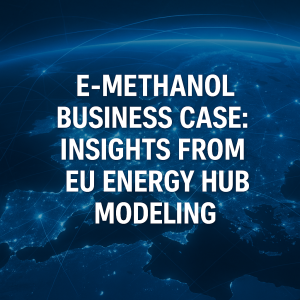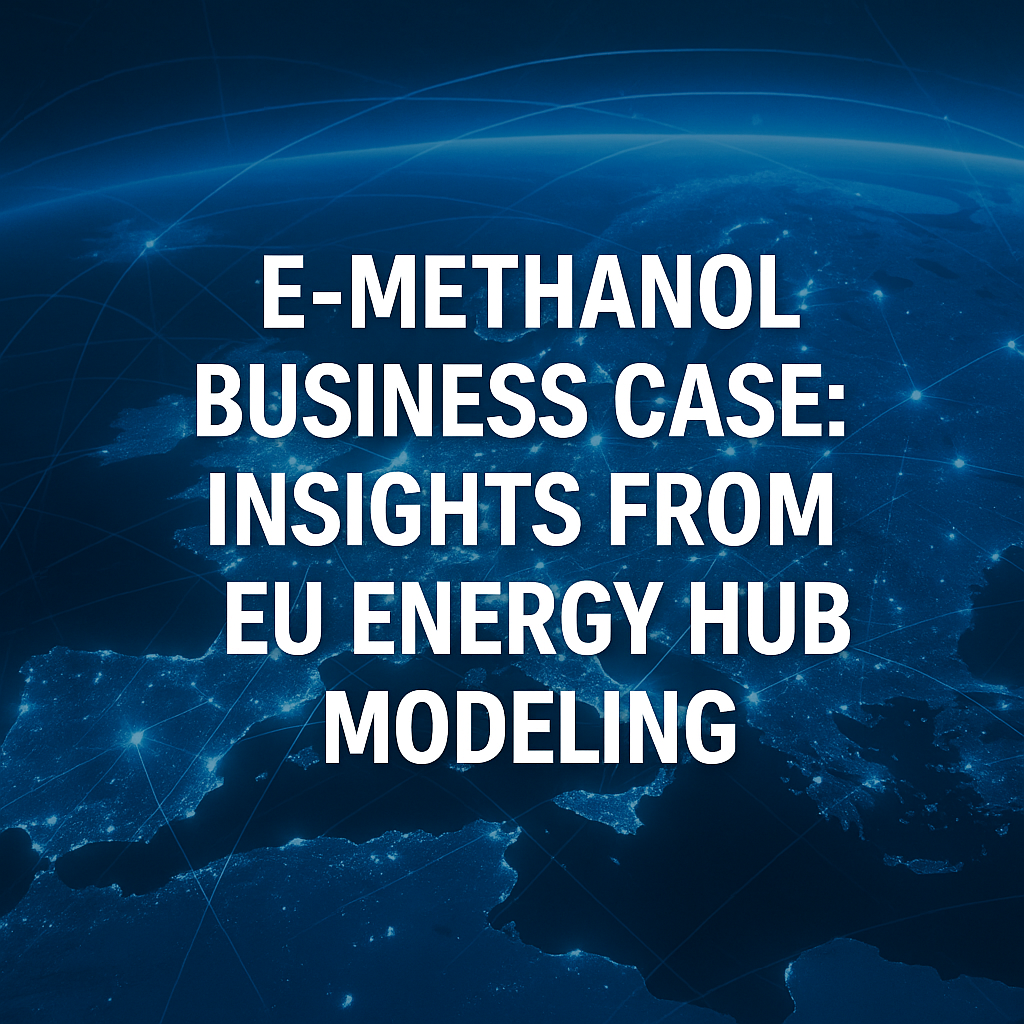Explore the business case for e-methanol in shipping. Learn from EU energy hub modeling about costs, infrastructure, challenges, and future decarbonization trends.
 As the shipping industry races to decarbonize, e-methanol has emerged as one of the most promising alternative fuels. Produced by combining renewable hydrogen with captured carbon dioxide, e-methanol has the potential to cut greenhouse gas emissions by more than 90% compared to conventional marine fuels. Unlike hydrogen or ammonia, it is liquid at ambient conditions, can be stored and transported with existing infrastructure, and is already supported by commercially available dual-fuel engines.
As the shipping industry races to decarbonize, e-methanol has emerged as one of the most promising alternative fuels. Produced by combining renewable hydrogen with captured carbon dioxide, e-methanol has the potential to cut greenhouse gas emissions by more than 90% compared to conventional marine fuels. Unlike hydrogen or ammonia, it is liquid at ambient conditions, can be stored and transported with existing infrastructure, and is already supported by commercially available dual-fuel engines.
Recent EU energy hub modeling for 2030 and beyond has provided new insights into the economic and operational viability of e-methanol as a scalable marine fuel. The European Union, through its energy transition roadmaps and policy instruments like FuelEU Maritime and the EU Emissions Trading System (ETS), is actively shaping a market where green fuels must compete not only on technical feasibility but also on commercial viability.
The central question is: can e-methanol deliver a competitive business case for shipowners, ports, and energy suppliers by 2030 and beyond?
This article explores that question by analyzing why e-methanol matters, the technological and policy developments supporting it, the challenges and potential solutions, case studies from Europe and abroad, and the long-term trends shaping its future role in global maritime decarbonization.
–
Why This Topic Matters in Maritime Operations
The maritime sector is both a lifeline of global trade and a significant source of greenhouse gas emissions. According to the Fourth IMO GHG Study, international shipping emitted over 1 billion tonnes of CO₂ in 2018, accounting for nearly 3% of global emissions. Left unchecked, this share could grow as global trade volumes increase.
The IMO’s 2023 GHG reduction strategy sets a clear path: reduce total GHG emissions from shipping by 20% by 2030 (striving for 30%), 70% by 2040, and reach net-zero by 2050. Achieving these targets requires an unprecedented shift from heavy fuel oil to low- and zero-carbon alternatives.
E-methanol matters for several reasons:
-
Scalability Potential
Unlike biofuels limited by feedstock availability, e-methanol can be produced at scale in regions with abundant renewable energy. EU energy hub modeling highlights the North Sea, Baltic, and Mediterranean as potential production and bunkering centers. -
Infrastructure Compatibility
Because it is liquid at ambient conditions, e-methanol can use existing bunkering infrastructure with modifications, avoiding the costly overhaul required for hydrogen or ammonia. -
Technology Readiness
Major engine manufacturers like MAN Energy Solutions and Wärtsilä already supply dual-fuel methanol engines, and over 200 methanol-ready ships are on order globally, with deliveries stretching into the late 2020s. -
Policy Alignment
E-methanol aligns with EU policies that incentivize renewable fuels of non-biological origin (RFNBOs). Under FuelEU Maritime, using e-methanol can reduce compliance costs and avoid penalties for carbon intensity breaches.
In short, e-methanol is not just a theoretical fuel of the future; it is a practical option with a clear regulatory and technological pathway for the 2030 horizon.
–
Key Developments, Innovations, or Technologies
Production Pathways
E-methanol is produced through a two-step process:
-
Renewable Hydrogen Production – Electrolysis of water using renewable electricity (wind, solar, hydro).
-
Carbon Capture – CO₂ captured from industrial processes or directly from the air.
These inputs are combined via catalytic synthesis to produce methanol.
Compared to bio-methanol, which depends on agricultural residues or municipal waste, e-methanol is more scalable in the long run because it relies on renewable electricity and CO₂, both of which can be sourced globally.
EU Energy Hub Modeling
Recent modeling studies commissioned by the European Commission’s Directorate-General for Energy (DG ENER) and supported by research institutes show:
-
By 2030, Europe could produce 4–6 million tonnes of e-methanol annually, with costs ranging from €800–1,200 per tonne, depending on electricity prices and CO₂ capture methods.
-
By 2040, costs could fall below €600 per tonne, making e-methanol increasingly competitive with conventional marine fuels, especially under carbon pricing.
-
Major energy hubs like Rotterdam, Antwerp-Bruges, and Hamburg are expected to play a pivotal role as production, storage, and distribution centers.
Ship Technology and Engine Innovation
-
Dual-Fuel Engines: MAN Energy Solutions’ methanol-capable ME-LGIM engines are already in operation.
-
Safety Systems: Classification societies (e.g., DNV, Lloyd’s Register, ABS) have issued guidelines for methanol bunkering and onboard handling.
-
Retrofit Potential: Existing LNG-ready or methanol-capable designs make retrofitting feasible, offering flexibility to shipowners.
Green Corridors
The concept of green corridors — trade routes where zero-emission fuels and technologies are supported by governments and industry coalitions — is central to scaling e-methanol. The EU is exploring North Sea–Baltic corridors where e-methanol could become the preferred fuel by 2030, supported by coordinated investments in production and bunkering.
–
Challenges and Practical Solutions
1. High Production Costs
E-methanol remains more expensive than heavy fuel oil or LNG. Production costs are driven by electricity prices and carbon capture expenses.
Solution:
- Subsidies for renewable hydrogen and carbon capture.
- Long-term contracts between shipowners and fuel producers to provide investment security.
2. Limited Renewable Energy Supply
Competition for renewable electricity between sectors (power, steel, aviation) could limit availability for e-methanol.
Solution:
- Development of offshore wind hubs dedicated to fuel production.
- Cross-sector coordination to prioritize maritime fuels where alternatives are limited.
3. Certification and Verification
Ensuring that e-methanol is truly green requires robust certification systems. Without this, fossil-based methanol could dilute emissions benefits.
Solution:
- Adoption of ISCC PLUS and EU RED II compliance schemes.
- Transparent lifecycle assessment methodologies.
4. Safety and Handling
Methanol is toxic and flammable, requiring strict safety measures for storage and handling.
Solution:
- Updated IMO IGF Code for low-flashpoint fuels.
- Crew training under STCW amendments and guidance from classification societies.
–
Case Studies / Real-World Applications
Port of Rotterdam: Methanol Hub Development
Rotterdam is positioning itself as a methanol hub, with projects to integrate e-methanol production with offshore wind farms and CO₂ pipelines from industrial clusters. By 2030, the port aims to supply over 1 million tonnes annually for shipping.
Maersk’s E-Methanol Vessels
Maersk has ordered 25 dual-fuel container ships capable of running on methanol, signaling strong demand for green fuels. These ships are expected to consume over 1 million tonnes of methanol annually by 2030, creating demand certainty for producers.
EU Green Corridor Initiatives
The European Commission, together with shipping lines and ports, is piloting Baltic Sea green corridors where e-methanol will be tested at scale, providing lessons for global replication.
–
Future Outlook & Trends
-
Cost Parity with Fossil Fuels
With economies of scale and declining renewable energy costs, e-methanol could achieve cost parity with fossil fuels by the late 2030s, particularly under carbon pricing. -
Global Production Hubs
Beyond Europe, countries with abundant renewable energy (Chile, Saudi Arabia, Australia) are positioning themselves as exporters of green methanol. -
Multi-Fuel Future
Shipping will not rely on one fuel alone. Instead, methanol, ammonia, LNG, and hydrogen will coexist, with methanol likely dominating container shipping in the near to medium term. -
Integration with Carbon Markets
Under the EU ETS, shipowners using e-methanol could avoid significant carbon costs, making it financially attractive. -
Wider Adoption Across Ship Types
While container ships lead the way, tankers, bulk carriers, and ferries are expected to follow, with methanol as a common choice for short-sea and deep-sea routes.
–
FAQ Section
Q1: What is the difference between e-methanol and bio-methanol?
A: E-methanol is produced from renewable hydrogen and captured CO₂, while bio-methanol is made from biomass or waste. E-methanol is more scalable long-term.
Q2: Is e-methanol safe for ships?
A: Yes, with proper safety systems and crew training. It is toxic and flammable but manageable under international safety codes.
Q3: How expensive is e-methanol compared to heavy fuel oil?
A: Currently 2–3 times more expensive, though costs are expected to decline by 2030–2040.
Q4: Can existing ships be converted to use e-methanol?
A: Many vessels can be retrofitted with methanol-capable engines and fuel systems, though costs vary depending on ship design.
Q5: Will e-methanol be widely available by 2030?
A: EU energy hub modeling suggests Europe could produce 4–6 million tonnes annually by 2030, enough to fuel a significant portion of the fleet.
Q6: How does e-methanol compare to ammonia or hydrogen?
A: E-methanol is more technologically ready and infrastructure-compatible, though ammonia and hydrogen may play roles in the long-term energy mix.
Q7: Why is the EU focusing on e-methanol?
A: It aligns with EU renewable energy policies, can be produced at scale with offshore wind, and offers a near-term pathway to reduce shipping emissions.
Conclusion
The business case for e-methanol is becoming clearer as EU energy hub modeling for 2030 and beyond provides concrete insights into production costs, infrastructure needs, and policy alignment. While challenges remain — particularly around cost and renewable energy supply — the combination of regulatory incentives, technological readiness, and growing demand from leading shipping companies creates a strong foundation for scaling.
For shipowners, ports, and energy suppliers, the message is straightforward: investing in e-methanol today is not only a climate imperative but also a strategic business decision for the decarbonized maritime economy of tomorrow.
References
-
International Maritime Organization (IMO). (2023). Revised GHG Reduction Strategy.
-
European Commission. (2023). FuelEU Maritime Regulation.
-
DNV. (2023). Maritime Forecast to 2050.
-
Lloyd’s List Intelligence. (2023). Alternative Fuels Outlook.
-
MAN Energy Solutions. (2022). Methanol Dual-Fuel Engine Specifications.
-
Wärtsilä. (2023). Methanol as a Marine Fuel – Technical Insights.
-
UNCTAD. (2022). Review of Maritime Transport.
-
European Parliament. (2023). EU Emissions Trading System for Shipping.
-
Port of Rotterdam Authority. (2023). Methanol Hub Development Strategy.
-
Ocean Engineering Journal. (2022). Lifecycle Analysis of Alternative Marine Fuels.

